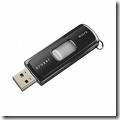
Solid State Drive Vs Hard Drive Vs USB Flash Drive
 Solid state drives (SSD): used in the enterprise are data storage devices that use non-moving fl ash memory technology rather than rotating magnetic disks or optical media. SSDs are compatible with traditional hard drive interfaces, such as SATA or SAS, and have a familiar hard drive form factor, such as 3.5-, 2.5- or 1.8-inch.
Solid state drives (SSD): used in the enterprise are data storage devices that use non-moving fl ash memory technology rather than rotating magnetic disks or optical media. SSDs are compatible with traditional hard drive interfaces, such as SATA or SAS, and have a familiar hard drive form factor, such as 3.5-, 2.5- or 1.8-inch.
USB Flash Drive: consists of a flash memory data storage device integrated with a USB (Universal Serial Bus) interface. USB flash drives are typically removable and rewritable, and physically much smaller than a floppy disk. Most weigh less than 30 g (1 oz). Storage capacities in 2010 can be as large as 256 GB with steady improvements in size and price per capacity expected. Some allow 1 million write or erase cycles and have a 10-year data retention cycle.
USB flash drives are often used for the same purposes as floppy disks were. They are smaller, faster, have thousands of times more capacity, and are more durable and reliable because of their lack of moving parts. Until approximately 2005, most desktop and laptop computers were supplied with floppy disk drives, but most recent equipment has abandoned floppy disk drives in favor of USB ports.
USB Flash Drives Vs Solid State Drives
Both USB flash drives and SSDs use NAND fl ash memory. However, it’s the quality of NAND used—as well as the controller and interface involved—that separates a simple USB fl ash drive from an enterprise-class storage device, like those found in blade servers and external storage systems.
Solid State Drives Vs Hard Drives
Today’s SSDs are different from hard drives when it comes to data storage. SSDs are sophisticated storage devices that use non-moving memory chips, mostly non-volatile NAND fl ash, instead of the rotating magnetic disks found in hard drives. Hard drives can take the data directly from the host and write it to the rotating media. In contrast, SSDs can’t write a single bit of information without first erasing and then rewriting very large blocks of data at one time (also referred to as P/E).
Because SSDs and hard drives have different strengths in terms of effi ciency, they complement each other and can co-exist. SSDs deliver ultra-fast random data access (inputs-outputs per second, or IOPS, performance), low power consumption, small size and high physical resilience (due to no moving parts)— but they cost more. Hard drives provide fast sequential data access with high capacity, endurance and reliability at a much lower price.


 A USB flash drive is a NAND type flash memory. The NAND type flash memory was designed for the exchange and saving of data as alternative to the magnetic disk. The NAND type flash memory has the capacity to hold large volumes of data. The writing and erasing speed is also fast. The USB drive can be easily inserted into the USB port of the computer. With the help of USB flash drive, data can be safely and easily transferred. The USB drive is more reliable and safer than the floppy disks. The USB drives are small and compact.
A USB flash drive is a NAND type flash memory. The NAND type flash memory was designed for the exchange and saving of data as alternative to the magnetic disk. The NAND type flash memory has the capacity to hold large volumes of data. The writing and erasing speed is also fast. The USB drive can be easily inserted into the USB port of the computer. With the help of USB flash drive, data can be safely and easily transferred. The USB drive is more reliable and safer than the floppy disks. The USB drives are small and compact.